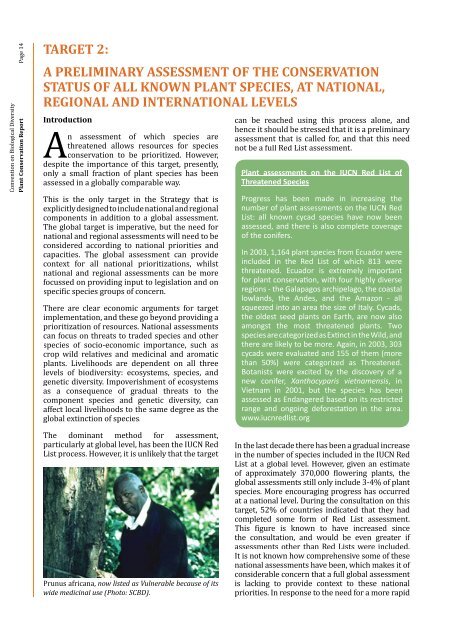from the global partnership for plant conservation
from the global partnership for plant conservation
from the global partnership for plant conservation
You also want an ePaper? Increase the reach of your titles
YUMPU automatically turns print PDFs into web optimized ePapers that Google loves.
Convention on Biological DiversityPlant Conservation Report Page 14TARGET 2:A PRELIMINARY ASSESSMENT OF THE CONSERVATIONSTATUS OF ALL KNOWN PLANT SPECIES, AT NATIONAL,REGIONAL AND INTERNATIONAL LEVELSIntroductionAn assessment of which species arethreatened allows resources <strong>for</strong> species<strong>conservation</strong> to be prioritized. However,despite <strong>the</strong> importance of this target, presently,only a small fraction of <strong>plant</strong> species has beenassessed in a <strong>global</strong>ly comparable way.This is <strong>the</strong> only target in <strong>the</strong> Strategy that isexplicitly designed to include national and regionalcomponents in addition to a <strong>global</strong> assessment.The <strong>global</strong> target is imperative, but <strong>the</strong> need <strong>for</strong>national and regional assessments will need to beconsidered according to national priorities andcapacities. The <strong>global</strong> assessment can providecontext <strong>for</strong> all national prioritizations, whilstnational and regional assessments can be morefocussed on providing input to legislation and onspeciic species groups of concern.There are clear economic arguments <strong>for</strong> targetimplementation, and <strong>the</strong>se go beyond providing aprioritization of resources. National assessmentscan focus on threats to traded species and o<strong>the</strong>rspecies of socio-economic importance, such ascrop wild relatives and medicinal and aromatic<strong>plant</strong>s. Livelihoods are dependent on all threelevels of biodiversity: ecosystems, species, andgenetic diversity. Impoverishment of ecosystemsas a consequence of gradual threats to <strong>the</strong>component species and genetic diversity, canaffect local livelihoods to <strong>the</strong> same degree as <strong>the</strong><strong>global</strong> extinction of species.can be reached using this process alone, andhence it should be stressed that it is a preliminaryassessment that is called <strong>for</strong>, and that this neednot be a full Red List assessment.Plant assessments on <strong>the</strong> IUCN Red List ofThreatened SpeciesProgress has been made in increasing <strong>the</strong>number of <strong>plant</strong> assessments on <strong>the</strong> IUCN RedList: all known cycad species have now beenassessed, and <strong>the</strong>re is also complete coverageof <strong>the</strong> conifers.In 2003, 1,164 <strong>plant</strong> species <strong>from</strong> Ecuador wereincluded in <strong>the</strong> Red List of which 813 werethreatened. Ecuador is extremely important<strong>for</strong> <strong>plant</strong> <strong>conservation</strong>, with four highly diverseregions - <strong>the</strong> Galapagos archipelago, <strong>the</strong> coastallowlands, <strong>the</strong> Andes, and <strong>the</strong> Amazon - allsqueezed into an area <strong>the</strong> size of Italy. Cycads,<strong>the</strong> oldest seed <strong>plant</strong>s on Earth, are now alsoamongst <strong>the</strong> most threatened <strong>plant</strong>s. Twospecies are categorized as Extinct in <strong>the</strong> Wild, and<strong>the</strong>re are likely to be more. Again, in 2003, 303cycads were evaluated and 155 of <strong>the</strong>m (morethan 50%) were categorized as Threatened.Botanists were excited by <strong>the</strong> discovery of anew conifer, Xanthocyparis vietnamensis, inVietnam in 2001, but <strong>the</strong> species has beenassessed as Endangered based on its restrictedrange and ongoing de<strong>for</strong>estation in <strong>the</strong> area.www.iucnredlist.orgThe dominant method <strong>for</strong> assessment,particularly at <strong>global</strong> level, has been <strong>the</strong> IUCN RedList process. However, it is unlikely that <strong>the</strong> targetPrunus africana, now listed as Vulnerable because of itswide medicinal use (Photo: SCBD).In <strong>the</strong> last decade <strong>the</strong>re has been a gradual increasein <strong>the</strong> number of species included in <strong>the</strong> IUCN RedList at a <strong>global</strong> level. However, given an estimateof approximately 370,000 lowering <strong>plant</strong>s, <strong>the</strong><strong>global</strong> assessments still only include 3-4% of <strong>plant</strong>species. More encouraging progress has occurredat a national level. During <strong>the</strong> consultation on thistarget, 52% of countries indicated that <strong>the</strong>y hadcompleted some <strong>for</strong>m of Red List assessment.This igure is known to have increased since<strong>the</strong> consultation, and would be even greater ifassessments o<strong>the</strong>r than Red Lists were included.It is not known how comprehensive some of <strong>the</strong>senational assessments have been, which makes it ofconsiderable concern that a full <strong>global</strong> assessmentis lacking to provide context to <strong>the</strong>se nationalpriorities. In response to <strong>the</strong> need <strong>for</strong> a more rapid
















